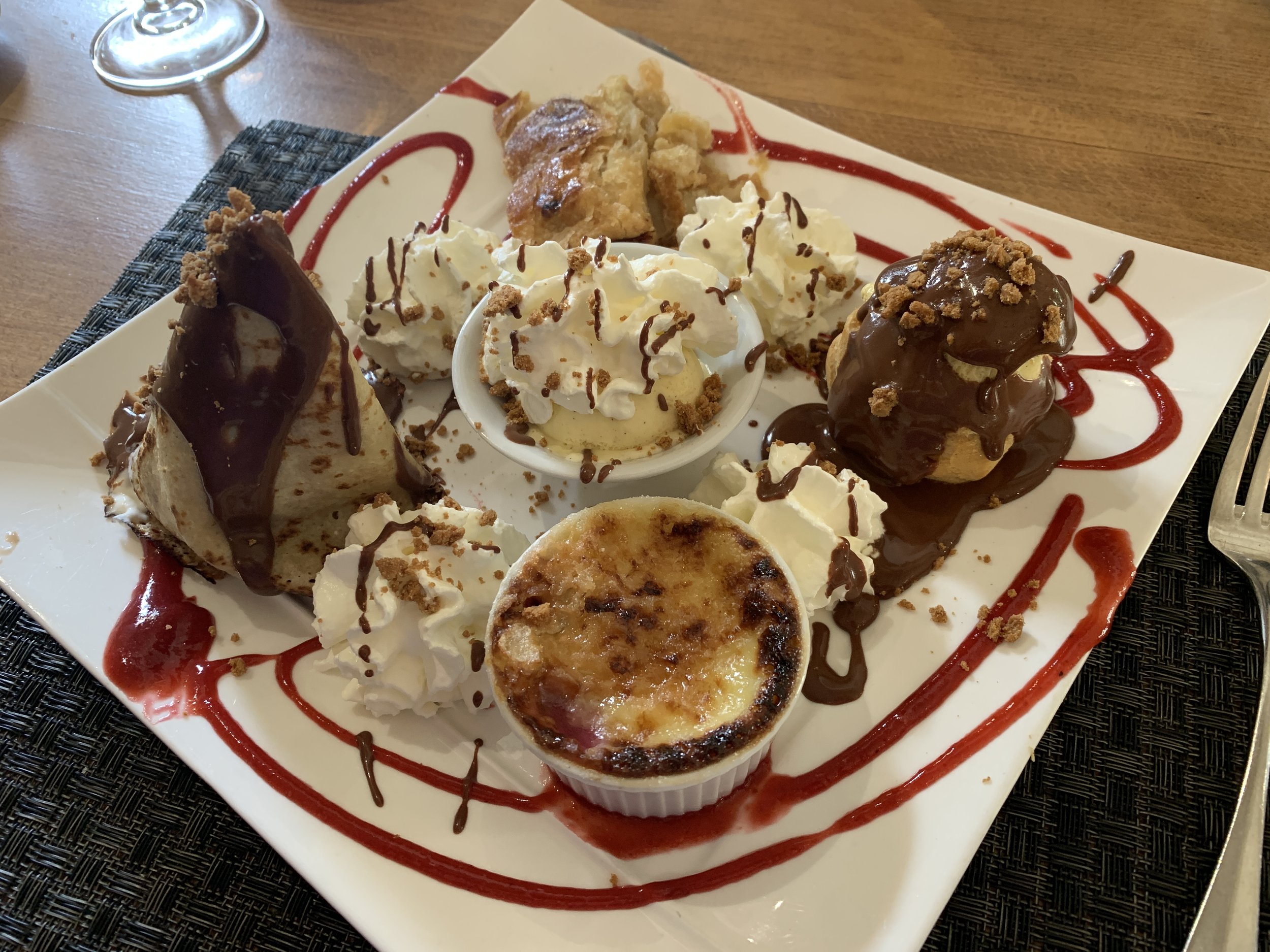Desserts in Bordeaux and a bit beyond
/Warning! Lots of dessert talk coming up. Trust me, I rarely eat dessert at home.
After spending 10 days in Catalonia, off to Bordeaux we went to meet up with our British friends Richard and Pauline. From the pastry standpoint, canelés are the iconic Bordelaise treat and the company Baillardran the most recognized name for these caramelized mini flans.
I make canelés on occasion and am thinking it’s time to do that again, particularly after tasting them in Bordeaux. Here’s a post I wrote on them quite awhile back. On this trip I learned from our French friend Marie (who attended university in Bordeaux) that one can choose canelés on a scale of 1 to 3: 1 being less baked/lighter in color and thus a less caramel-y, crispy exterior and 3 being most baked with a darker caramel crust of sorts. The interiors will be more soft and custardy with 1 and less so with 3. Get it? This was also confirmed by French friend Valerie who prefers the darker caramelized exterior. To each her own.
I had no idea that canelés are used to create more elaborate desserts. But why not, eh? Below are three different versions of ostensibly the same canelé profiterole dessert experienced at three different eateries - quite a contrast I think.
The first was for Steve and Richard at our hotel - an interesting approach with canelés split in half, topped with ice cream and accompanied by Chantilly and chocolate sauce. They enjoyed it. I wondered about calling them profiteroles . . . when in Rome.
First night’s version
The next evening at Le Bistro de Musée Richard and Steve opted for a similar dessert, this one more polished, with a more professional presentation and tasty to boot.
Second night’s version
I however made the mistake (retrospectively) of ordering a similarly described dessert the following evening at Chai Maestro which in my estimation was over the top portion wise. Fortunately Richard was there to finish what I could not.
Third night’s version
My favorite dessert in Bordeaux was at Le Bistro de Musée. I first experienced a Café Gourmand in Belgium during a trip to visit niece Christina and her family in Lille, France in 2016. Curiously enough, we met up with Richard and Pauline on that trip as well, visiting some of the WWI battlefields in Belgium and northern France.
Cafe gourmand at Markt 38 in Poperinge Belgium, 2016
On another visit to Lille in spring of 2018, we dined with Glen and Christina at a lovely restaurant in the city. Christina and I enjoyed delicious strawberry-pistachio tartelettes served with a vin jaune sorbet. Glen went with the café gourmand - a very broad selection of petite treats.
Café gourmand in Lille, spring 2018
The café gourmand I had in Bordeaux was on a smaller scale than many - right up my alley. Crème brulée (one of my faves), panna cotta/raspberry sauce and a moist apple cake. Perfect!
Café gourmand in Bordeaux, 2024
Training from Bordeaux to Agen and then by car to R&P’s home in Mouchan (near Condom in the Gers département de Gascogne), we spent a couple of days enjoying and appreciating their hospitality. Our visit was short but lovely after spending many nights in hotels.
We happened to be there on a Sunday, a day when many French enjoy a proper Sunday lunch out. We went to an auberge/chambre d’hôte out in the beautiful Gascon countryside where we were presented with the formule for the day. Water/wine already at the table, aperitif, amuse bouche, three courses (starter, plat principal and dessert), coffee and digestif all included (all for 31 euros, about $33). The food - absolutely scrumptious with a depth of flavor hard to be beat. It left us well satisfied without feeling stuffed to the gills.
Here’s where I made an interesting decision. Since I typically don’t order dessert (and rarely eat it at home), I spent a little time debating about ordering one at all. I went for the assiette gourmand, described to me by the staff as small (note I said small) portions of each of the five desserts on the menu. I love tasting, what can I say!
The image below shows you what I was faced with. As an aside, I noted that our table received some interesting looks from other diners (and even the staff) when the dessert was delivered as if to say “is she really going to eat all of that?”.
Ice cream and Chantilly cream played a large role in this assortment, as you can see below. From the left going clockwise: crêpe de noisette wrapped around ice cream, topped with chocolate sauce; apple croustade (my portion seemed to be from a corner of the pan without too much apple); profiterole (ahem - more ice cream); gratinée framboise - custard topped with raspberries and a sprinkle of sugar then run under the broiler. In the center - ice cream, rum sauce, Chantilly cream and some crunchy bits.
Whoa! Are you serious?
Yes, I did taste each one, preferring the gratinée and the apple crostade in terms of textures and flavors. Custard, fruit, flaky pastry - you bet. And yes, I did leave a fair amount on the plate (Richard didn’t even finish it off)! I’ll be more thoughtful if faced with the same decision in the future. Live and learn.
Country side near the Auberge (photo courtesy of Steve Soper)
Up next - Paris!


























